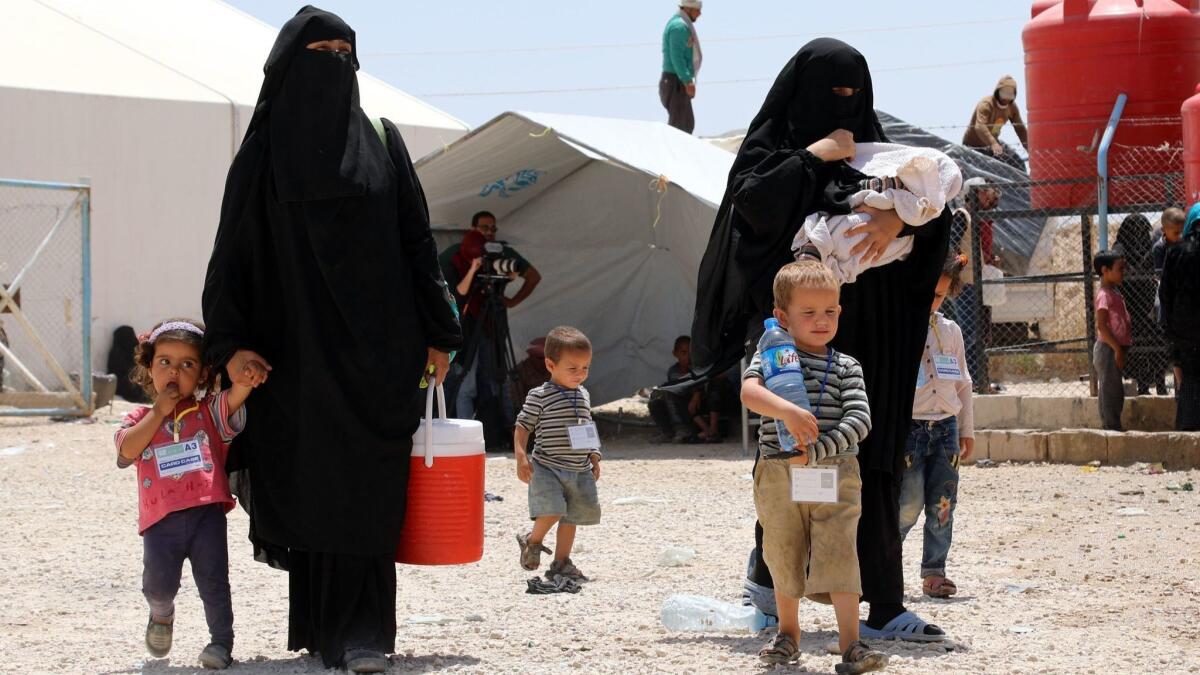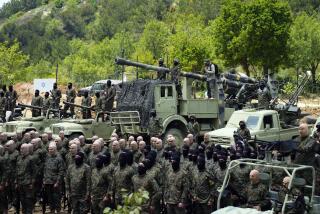Whether the U.S. fails or succeeds in Syria, tough choices lie ahead

As the perennial jousting between the U.S. and Iran focuses on drones, nuclear enrichment and safe passage of oil tankers through the Strait of Hormuz, Washington is struggling on a lesser watched front in the region: northeastern Syria.
That’s where the U.S. led a coalition of European and regional nations in support of a Kurdish-dominated group of militias against Islamic State extremists, lavishing the Kurds with weapons, training, air cover and the assistance of thousands of U.S. soldiers and contractors.
With Islamic State having been ousted from all the territory it held, the Kurdish-led fighters known as the Syrian Democratic Forces, or SDF, now control one-third of Syria. Washington wants to solidify that control, promote the SDF as a viable government and deny the resource-rich region to Syrian President Bashar Assad and his backers in Iran and Russia — even as President Trump has pushed to withdraw all U.S. personnel.
But such ongoing Kurdish-led control clashes with competing local and international rivalries, and faces strong pushback from allies and enemies alike.
Just across the Euphrates River from the SDF lie Syrian government troops, Russian contractors, Iranian-backed paramilitaries and advisors from Iran’s Revolutionary Guard Corps. They wait for the opportunity to fulfill Damascus’ long-stated vow to take back every inch of Syria’s territory, including the SDF enclave.
If they succeed, Syria’s borders would form part of what many believe is Tehran’s grand design to forge a land bridge connecting Iran to Lebanon. That, they say, would allow it to more easily transport weapons to its proxies and to build a network to circumvent U.S. economic sanctions.
Beyond the SDF enclave’s northern border lies Turkey, a North Atlantic Treaty Organization ally that has grown increasingly angry at the U.S. for its support of the People’s Protection Units, the dominant Kurdish militia within the SDF. Turkey insists the group is a proxy for the separatist Kurdish movement it has fought for decades at home; it has threatened to overrun the group’s bastion and install its own Syrian rebel factions in power.
The U.S. has sought to placate Turkey with talk of a so-called safe or buffer zone, which would see the gradual withdrawal of the Kurdish force from the border and the destruction of its military fortifications. The evacuated areas would be patrolled by Turkish soldiers along with the U.S. and other coalition service members.
But European allies remain unconvinced. Last month, James Jeffrey, the U.S. special representative for Syria, said that initial plans for Europe’s participation in the safe zone had gone nowhere.
Students in Syria are a textbook case for post-Islamic State reeducation »
Meanwhile, the Trump administration’s hopes for a so-called Arab NATO appear to be crumbling. Saudi Arabia has so far failed to entice its allies in the region to join and Egypt has reportedly withdrawn.
Discussions are continuing, said one diplomat, who spoke on condition of anonymity, but losing Cairo’s support would deal a death blow to a coalition which presumably would have contributed troops to a safe zone.
The SDF, meanwhile, has little interest in giving up territories it clawed back from the Islamist extremists, especially to Turkish-backed Syrian rebels who view the Kurds as atheist separatists and the Arabs allied with them as traitors to the anti-Assad cause.
There are also fractures within the SDF’s enclave.
The deserts of eastern Syria are home to Arab tribes whose members extend across the borders of Iraq and Saudi Arabia. Some, such as the Shaitat tribe, were among the first victims of Islamic State’s rise in eastern Syria; hundreds were slaughtered when they rallied against the militant group. Their kin later joined the Kurds to dislodge the intruders.
The tribal people make up the majority population of eastern Syria, and though they were allies with the Kurds in combat, many have come to resent them in governance. There has been a persistent wave of demonstrations since April in areas of eastern Syria against Kurdish domination.
Many say that Kurdish security officers have imprisoned people wrongly accused of links to Islamic State, said Abdul Rahman Khadher, a Dair Alzour-based activist and member of the Shaitat tribe.
“At the same time, you see Daesh leaders paying money and being set free within 10 days, and even working with the SDF,” he said in a phone interview, referring to Islamic State by a derisive Arabic acronym. “They also employ incompetent people as administrators, people with a bad history who are implicated of being part of Daesh.”
In recent months, Russia has sent emissaries to cajole the tribe members back to Assad’s fold. Last month, Thamer Sabhan, Saudi Arabia’s minister for gulf affairs, joined a delegation of U.S. officials to eastern Syria to mollify tribal representatives from the eastern Syrian province of Dair Alzour frustrated with the SDF. (His visit further angered Turkey, which is engaged in a duel over regional influence with Saudi Arabia.)
Islamic State’s caliphate is all but finished, but its online presence endures »
Then there is Islamic State. Surviving members and their sympathizers have scattered across the eastern Syrian desert. They have burned crops, planted bombs and conducted targeted assassinations as part of a campaign to terrorize the tribes into collaboration, while also targeting Kurdish fighters.
In mid-June, Islamic State claimed responsibility for a car bomb attack in the Kurdish-controlled city of Qamishli in which six people, including civilians, were wounded, activists said. Islamic State also acknowledged engaging in several shootings and attacks with homemade bombs on SDF militias across eastern Syria.
Hanging over any discussion of the enclave is the question of whether the U.S. will withdraw its remaining troops from the area, and just what its policy will be moving forward.
Under the Obama administration, U.S. officials had pushed the Kurds to negotiate a deal with Damascus over the land. But the Kurds, said Dareen Khalifa, a senior analyst with the International Crisis Group, now have tens of thousands of fighters and a bureaucracy of 140,000 civil servants serving a population of roughly 2 million — and the Kurds control most of Syria’s oil, gas and water resources.
“Damascus didn’t negotiate, and the Kurds now had a taste of what autonomy looks like and they liked that, so they also want to negotiate from a much higher position than they had originally envisioned,” Khalifa said.
Negotiations broke off after Trump took office and began issuing statements inconsistent with those of leading officials in his administration.
Though Trump has consistently said he wanted out of Syria (“Our boys, our young women, our men — they’re all coming back, and they’re coming back now,” Trump tweeted in December), military and foreign affairs officials promised the U.S. was staying put.
“They’re very anti-regime, very anti-Iran, and they started sending the Kurds a different message, that they’ll enforce a no-fly zone, everything they want,” Khalifa said. “Even in December when he tweeted that we’re leaving very soon and that was the the end of it, Trump’s senior advisors were telling the Kurds not to rush to Moscow or sign off on a deal with Damascus.”
Now the U.S. strategy appears to have morphed into one that would pressure Assad into kicking out Iran and committing to a series of concessions that would either make his rule acceptable to the U.S. or lead to a transition away from it, said Nicholas Heras, a fellow at the Center for a New American Security. The SDF’s success would be part of that pressure.
“Essentially, the U.S. is calling for a regime-change strategy without calling it a regime-change strategy,” Heras said. At the same time, it is trying to build “a plane in flight, trying to create enduring resilience, governance, administrative, security, and economic recovery structures for the SDF.”
At a March briefing, Jeffrey, the special representative, said the U.S. policy for Syria is threefold: to “ensure the enduring defeat” of Islamic State, to “ensure a political process that will give us a different kind of government” and “thirdly, the removal of all Iranian-commanded forces from the entirety of Syria.”
Yet Assad has shown little appetite for negotiations, even though he faces a sanctions siege that has hobbled any chance of recovery from the devastating eight-year civil war he has weathered. With Russia and Iran behind him, it may take years until he submits.
With Assad remaining in Damascus, a successful SDF enclave would lead to a “looming handover problem,” Heras said. If the Trump team or successor administrations decide to invest in the stabilization of northeastern Syria, Assad could eventually control a region that is “rebuilt, rehabilitated and secured for free,” Heras said.
“Can the U.S. swallow the poison pill of handing over its presence in Syria to a government still led by Assad or by successors of his?” Heras asked.
More to Read
Sign up for Essential California
The most important California stories and recommendations in your inbox every morning.
You may occasionally receive promotional content from the Los Angeles Times.










